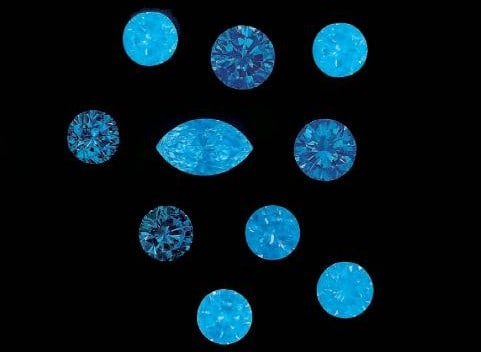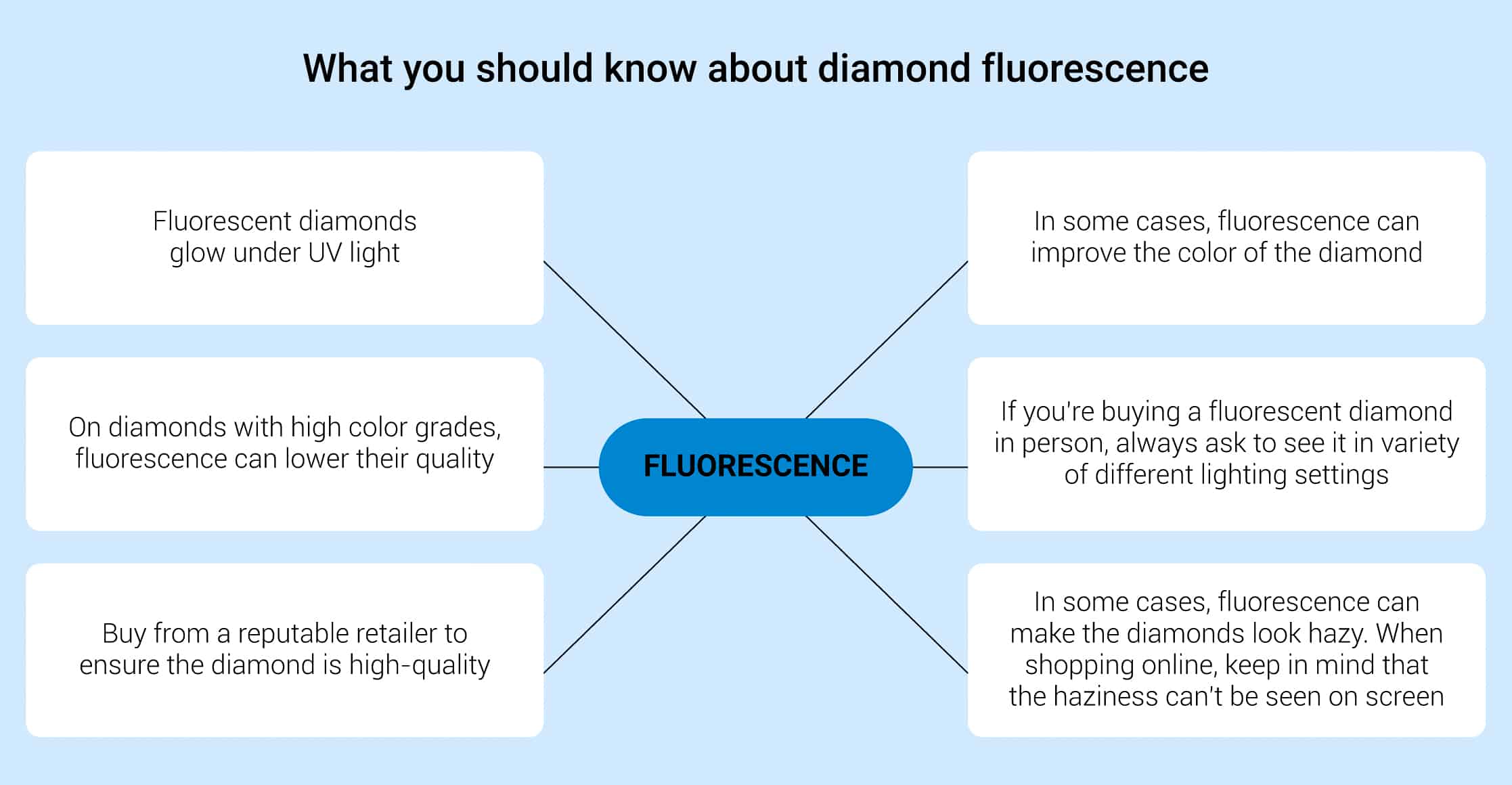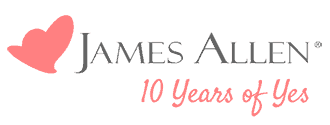What Is Diamond Fluorescence (And Why It Matters)?
Is diamond fluorescence good or bad and does it effect a diamonds value?
Is diamond fluorescence good or bad and does it effect a diamonds value?
Diamond fluorescence refers to the glow a diamond emits under ultra-violet (UV) light, often seen as a blue hue. The GIA has five fluorescence grades: None, Faint, Medium, Strong, and Very Strong. While 30% of diamonds exhibit this glow, its impact varies: it can enhance a diamond’s color or cause a hazy appearance. Understanding fluorescence is essential when choosing a diamond, as it can influence both its visual appeal and value.
When shopping for a diamond with fluorescence, ask to see the diamonds under UV and normal lighting, as well as inquire about how they may look when exposed to daylight and only buy from a reputable retailer with a GIA certificate.
Why you should trust us
How does diamond fluorescence look under UV light?
Diamond fluorescence – Diamond Pro explanation video
Should I buy a diamond that exhibits fluorescence?
Is diamond fluorescence good or bad?
7 tips on fluorescence
Strong blue fluorescence in diamonds
Does fluorescence improve diamond color?
FAQs about diamond fluorescence
Hesitations regarding fluorescence in diamonds
Diamonds with Medium to Very Strong Blue fluorescence will react to UV light by exhibiting a ghostly blue hue. From a visual perspective, this has minimal impact. Unless you work at a nightclub, you aren’t likely to spend your day seeing the diamond flashing from UV light.

If the diamond only glows when exposed to ultra-violet light, then it should naturally only matter if you are someone who spends their days in dark rooms with black light lamps. But the fact is, most diamonds exhibiting strong blue fluorescence appear slightly to severely hazy in regular lighting conditions.
If you’ve done your homework and googled diamond fluorescence, then you might have read about a certain GIA study claiming that even strong blue is almost always entirely imperceptible to the average diamond consumer.
Fluorescence in reference to diamonds still remains to be a widely misunderstood concept. When we talk about the fluorescence of a diamond, we are referring to the glow it has when it is exposed to ultra-violet light, and when it exhibits a blue color it appears higher in color than its true body color.
When purchasing a diamond, it’s important to take fluorescence into account. When fluorescence is utilized correctly, you can find a superb diamond like this one from James Allen. If you ignore fluorescence, you can make a huge mistake like this diamond from Blue Nile. A November 2019 report in Rapaport found that most consumers don’t think about fluorescence when diamond shopping and “the trade is missing out on an opportunity”.
While fluorescence can have a positive or negative effect on the diamond’s physical appearance (as we explain below), it definitely has a negative impact on price. If you are purchasing a diamond with an eye towards its investment value (especially a DEF color), avoid any fluorescence.
Fluorescence can be good or bad: it can improve a diamond’s color or make the diamond look hazy. When diamonds have Slight or Faint Fluorescence from GIA, for example, they don’t appear cloudy. In fact, the slight fluorescence can make the diamond appear more white. But when fluorescence makes the diamond hazy, the stone is less transparent. Light won’t reflect as well and the diamond won’t be as clear or beautiful.

The GIA grades fluorescence in diamonds as none, faint, medium, strong and very strong. Here are explanations of when fluorescence can lower a diamond’s quality:
I can tell you with absolute certainty, that their research is bunk. I have seen tens, if not hundreds, of thousands of diamonds in my career and I can tell you without question the following:
If the diamonds you are looking at have a strong or very strong blue fluorescence, then they will most likely appear hazy, oily, or cloudy and this will also cause the diamonds to appear less transparent. When comparing diamonds back to back, you will definitely see a difference between a diamond with strong fluorescence and one with little or none. It is also important to note that this extreme level of haziness for a fluorescent diamond is also not typical and is not as common as you may think when you are discussing diamonds that are H and lower.
Some studies done on fluorescence do make one claim that is correct. Fluorescence will usually improve the appearance of color in the diamond.
As I suggested in my bottom line recommendation above, if you are buying a diamond with a color H or lower, seek out a diamond with medium blue fluorescence.
I am hesitant to suggest looking for a diamond with strong blue fluorescence since even lower colors can occasionally look milky and hazy when they have strong blue fluorescence. But the lower you go in color grades, the less likely it will be milky. Here is an example of a beautiful J color diamond from James Allen that benefits from the strong fluorescence.
A medium blue fluorescent diamond color can even help counteract any yellowish tint the diamonds may have and can make them appear much whiter. In effect, this will make the diamond color and appearance an entire color grade higher.
Fluorescence can make the diamond shine and sparkle more than a diamond that lacks fluorescent properties.
Diamonds with fluorescence (especially strong blue grades) can glow in the dark. You will only see that blue hue under an ultra-violet (UV) light. This occurs in 30% of natural diamonds.
No, lab-grown diamonds do not have fluorescence. While it’s theoretically possible, we have not seen any in inventory.
I am also hesitant to suggest medium blue fluorescence when purchasing a diamond with very high color (G or better) since on rare occasions even a medium blue fluorescent diamond can exhibit milkiness or haziness when the color is exceptionally high.
If, of course, you are buying a diamond in person and not online, then it’s in your best interest to specifically ask for a diamond with strong blue fluorescence. You are best off asking us about any specific diamond you are looking at. Contact us and we’ll help you out.
It will be more affordable, and since you are there in person, you can see for yourself whether or not the diamond exhibits haziness or milkiness. Make sure to ask to see the diamond in a variety of different lighting settings, if possible.




Before you buy a diamond, get personal buying advice from industry veterans. We'll help you get the best diamond for the money.
DISCLAIMER: We don't use your email for marketing. Period.
A diamonds’ price is determined primarily by the 4 Cs of the diamond. On the wholesale level, diamond prices are first based on a diamond shape and
Buying an engagement ring is often one of the first major purchases in a person's life. The process can be fraught with tension as there are so m
A wide range of 1 carat diamonds exist both in online markets and local diamond jewelry stores. Not only are there significant differences in beauty
Please enter your email address to receive your 25% off coupon code:
Here is your coupon code: GFDSF3GF